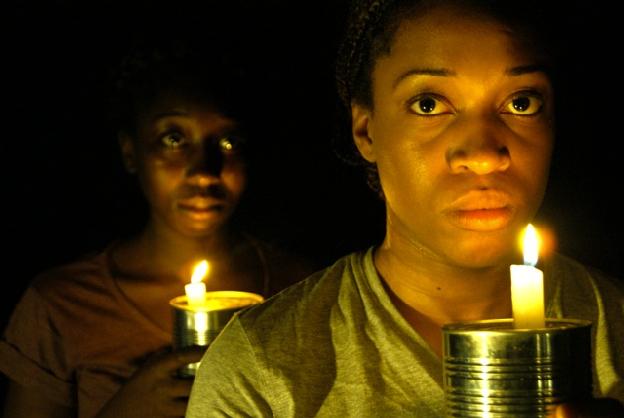A Place at the Table is the latest offering from Daedalus Theatre. Devised and written by the company, this performance is the full-length version of a scratch shown at Camden People’s Theatre in 2009.
It begins with the audience left waiting as the late-starting company make some unseen touches. Finally, we are invited into the darkened auditorium of Camden People’s Theatre. The layout is instantly unconventional: the raked seating is gone and the centre of the room is dominated by a vast wooden table fringed with seats. The edges of my vision fade to blackness as the only discernible light emanates from scattered desk lamps, which pick out the grain of the expansive woodwork and cast disfiguring shadows over the faces of the four female cast members who sit with us around the edge of the table.
From the outset the production is inherently political: it purports to explore the conflicting narratives which have shaped 20th Century Burundian history. Indeed, as an audience we become witnesses to various accounts of tragedies and massacres which litter the country’s recent history. The production attempts to unsettle the validity of the narrative line by providing contradictory recollections of the 1993 coup in which Burundian President Ndadaye was assassinated and over 200,000 people lost their lives.
Told using a mix of devised dialogue generated through workshops and verbatim material, drawn from sources including campaigners and refugees, A Place at the Table could have been an idealised or brutalised telling of victim and aggressor. Instead the Rwandan genocide and conflagration is cooled by ice cold dispassionate reports, read from ubiquitous case folders. I am left further cooled by the faux American accents, which are more distracting than enriching to the immersive performance. The piece attempts an episodic structure, but the disjointed and fractured performance feels like a series of exercises have been lifted straight out of the devising space and put on to the stage. The disjointed performance styles see a staged ‘summit’ become a naturalistic first-person narrative; table-climbing enthusiasm quickly changes to a piece of video work.
The overall result is both staccato and confusing; and while I admire the attempt to relay so much historical information, the disjointed mechanisms which Daedalus use prove more confusing and frustrating than the ‘facts’ of the coup and Hutu people. However, if one does not try to follow a narrative line or indeed become overly attached to a certain performance style, then the work does have its highlights. The huge table was cleverly reinvented as a backdrop for various performance vignettes, my personal favourite being the revelation of vast quantities of earth which were revealed as the tabletop was sequentially lifted. The raw soil was then dug through to unearth a variety of mobile phones and receivers, thereby creating a physical metaphor for the mineral rich deposits which made the Burundi land so valuable.
However, after seeing this I realise that Daedalus are well named, in that they have created a performance which feels impossible to navigate. A Place at the Table is an unsettling space where the audience becomes increasingly lost and is presented with constant stylistic dead ends and abandoned routes. Indeed, I am left wondering if the director/designer Paul Burgess wants the audience to connect to the piece at all or to view it objectively. Alienating the audience from the subject, the genre and the performers means that even the most loyal theatre patron will struggle to understand their own ‘place at the table’.


